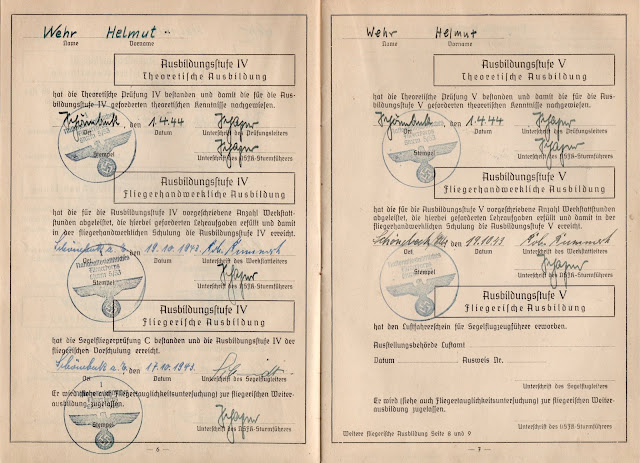NSFK
Radio Operator's Badge
Instituted on - 1941
Rarity – Very Rare.Known Makers – Unmarked.
NSFK Radio Operator's Badge - Obverse.
NSFK Radio Operator's Badge - Reverse.
The
badge comprises of a light blue cloth inverted triangle with rounded corners, machine
woven on blue-grey wool backing. The insignia measures approximately 53mm high
and 85 mm wide, which has a darker blue edge line. At the centre is a woven
pair of white wings on a blue-grey field, with a black Latin “B” encircled in a
black ring. From the circle are four lightning flashes, one
projecting
at each diagonal. The wings, central circle and flashes are in white, while the
outlines of the wings, together with its fletching, and flashes are black.
The
capital 'B' is for Bordfunker and the lightning flashes symbolise the
wireless.
The award was introduced
in 1941, however the illustration which accompanied the introduction of this
badge shows a Gothic B, but this may have been only the artist’s impression.
It was awarded
to students following demonstrated proficiency in practical tests and written
examination involving electronics and physics. Although radio training was
conducted in the classroom, flying experience was obligatory before the badge
was awarded. The student was required to have earned the International Glider
proficiency badge in at least the B Level – two gulls. The badge was
worn on the lower left arm of the service tunic and HJ uniform.
The student had
a Proficiency Book, which contained his photograph and personal details. This book
had the test undertaken and duly stamped. A certificate was also issued for the
award.
HJ Students undergoing lectures and training for the NSFK Radio Operator's qualification.
The badge can be seen on the left arm of the HJ Student in the fore ground.
NSFK Radio Operator's Badge - Qualification certificate.
NSFK Radio Operator's Badge - Qualification Book.
NSFK Radio Operator's Badge - Qualification Book - Inner page.
NSFK Radio Operator's Badge - Qualification Book - Page 1.
NSFK Radio Operator's Badge - Qualification Book -
Page 2 - 3.
NSFK Radio Operator's Badge - Qualification Book -
Page 4 - 5.
NSFK Radio Operator's Badge - Qualification Book -
Page 6 - 7.
NSFK Radio Operator's Badge - Qualification Book -
Page 10 - 11.
Wehr Helmut
The International Glider proficiency badge "A" can be seen on his lapel together with his HJ Proficiency miniature badge.
Civil
Gliding Proficiency Badge. A, B, C Certificate.
These
three awards are basically the same and can be found in three varieties. A cloth badge measuring approximately 50 mm,
produced in either silver-grey thread or silver bullion wire on a blue-grey
Melton backing. The badges consist of an
embroidered circle that measures approximately 40 mm with one, two or three
gulls to represent the grade of the award.
The third variety is a smaller metal badge with a raised outer edge
line. The relevant gull or gulls have a
similar raised line and the resultant fields are in filled with blue and white
opaque enamel.
A
Certificate.
30-second free flight with no manoeuvres
required.
B
Certificate.
60-second free flight with 'S' turn
manoeuvre. This also
Qualified the recipient for the German Glider
Permit.
C
Certificate.
It was necessary to make a 5-minute flight
without losing height
and pass an aural examination. This qualified the recipient for
the official Soaring Licence.
Achievement
C Certificate.
This
badge was referred to as the Leistungsprüfung C, as well as the
Leistungsabzeichen. This is assumed to
have been awarded for long duration flights with a much higher standard
aeronautical skills being required with flights in excess of five hours. It has been stated that two types of badge
were employed for the higher awards and these are the silver badge, which had
three gulls enclosed in a silver wreath of oak leaves and the golden badge,
which had three gulls in a gilt wreath.
It has also been reported that this grade has been encountered in an A
Certificate, which has one gull surrounded by an oak leaf wreath and a B
Certificate with two gulls surrounded by an oak leaf wreath. These were all supposedly for long duration
flights. In January 1942 the silver
badge was replaced by the NSFK Large Glider Pilots Badge.
These
badges were instituted by the International Aeronautical Federation, F‚d‚ration
A‚ronautique Internationale before the second world war and, it must be
stressed, are still in use today. They
were for varying degrees of proficiency in gliding. As the Versailles Treaty forbade a German air
force, this left gliding as the only alternative of learning the art of
civilian flying for commercial or private purposes. Because of the cost of motor driven aircraft,
Germans turned to the sport of gliding and soaring which proved to be an
excellent cover for training future pilots of the clandestine Luftwaffe. Fledgling pilots had to be tested and were
judged under the rules of the International Aeronautical Federation. Qualified pilots were authorised to wear the
badges on their respective uniforms on the left breast pocket. Germany and Italy are believed to be the only
countries to allow such badges to be worn on their service uniforms. The metal
badges were to be worn on the left lapel of civilian clothing.
International Glider proficiency badge A Level – one gulls. - Bullion - Obverse.
International Glider proficiency badge B Level – two gulls. - Bullion - Obverse.
International Glider proficiency badge C Level – three gulls. - Bullion - Obverse.
NSFK Radio Operator's Badge - Swastika.
NSFK Radio Operator's Badge - Swastika - Obverse.
NSFK Radio Operator's Badge - Swastika - Reverse.
NSFK Radio Operator's Badge - Swastika - Obverse Fake.
NSFK Radio Operator's Badge - Swastika - Reverse Fake.



















